Abstract
Three studies are presented in which environmental correlates of self-injurious behavior were systematically examined and later used as the basis for treatment. In Study 1, 7 developmentally disabled subjects were exposed to a series of conditions designed to identify factors that maintain self-injurious behavior: attention contingent on self-injurious behavior (positive reinforcement), escape from or avoidance of demands contingent on self-injurious behaviour (negative reinforcement), alone (automatic reinforcement), and play (control). Results of a multielement design showed that each subject's self-injurious behavior occurred more frequently in the demand condition, suggesting that the behavior served an avoidance or escape function. Six of the 7 subjects participated in Study 2. During educational sessions, "escape extinction" was applied as treatment for their self-injurious behavior in a multiple baseline across subjects design. Results showed noticeable reduction or elimination of self-injurious behavior for each subject and an increase in compliance with instructions in all subjects for whom compliance data were taken. The 7th subject, whose self-injurious behavior during Study 1 occurred in response to medical demands (i.e., physical examinations), participated in Study 3. Treatment was comprised of extinction, as in Study 2, plus reinforcement for tolerance of the examination procedure, and was evaluated in a multiple baseline across settings design. Results showed that the treatment was successful in eliminating self-injurious behavior and that its effects transferred across eight new therapists and three physicians. General implications for the design, interpretation, and uses of assessment studies are discussed.
Full text
PDF
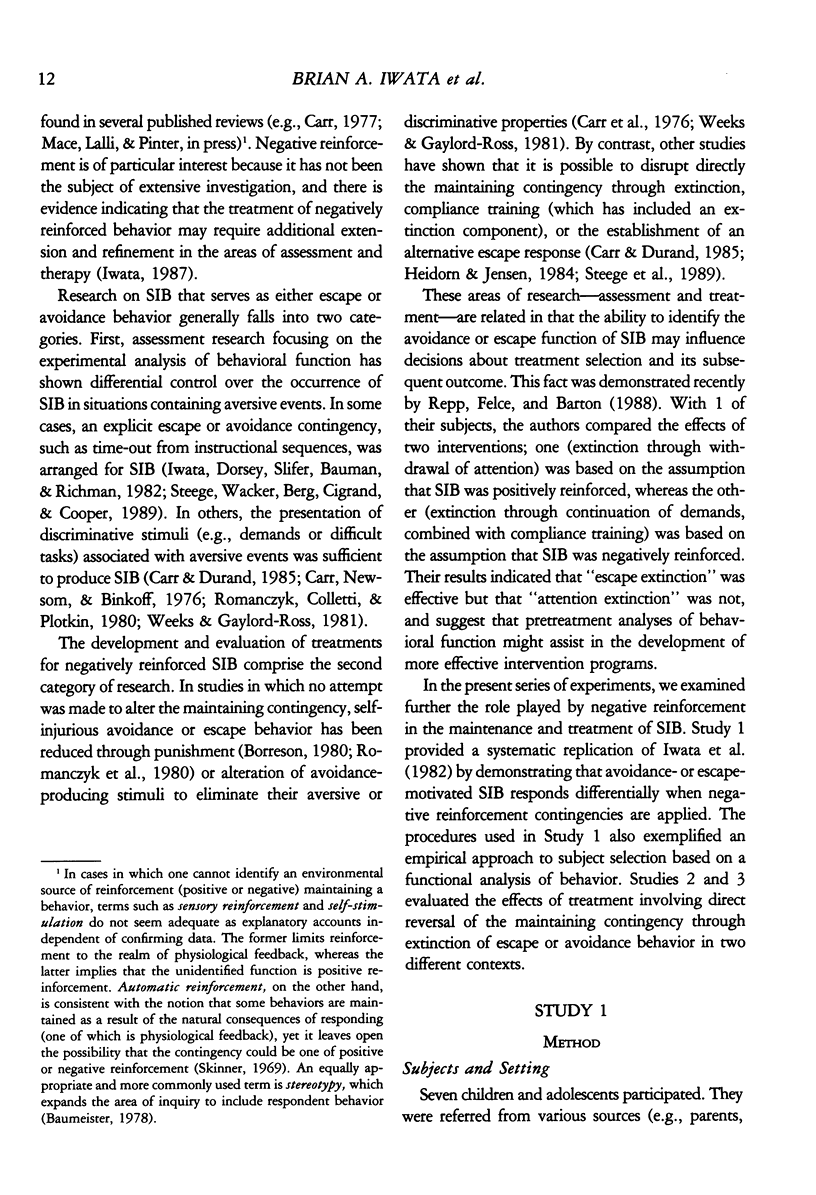
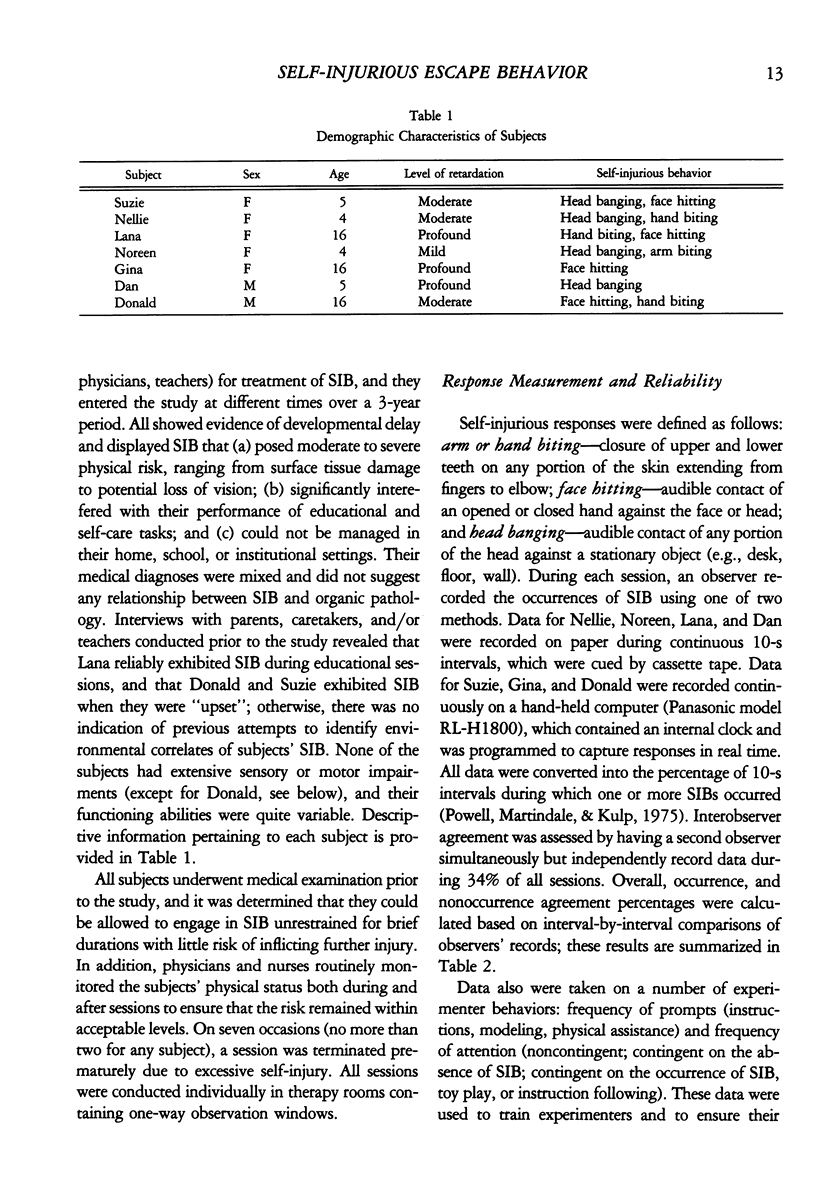

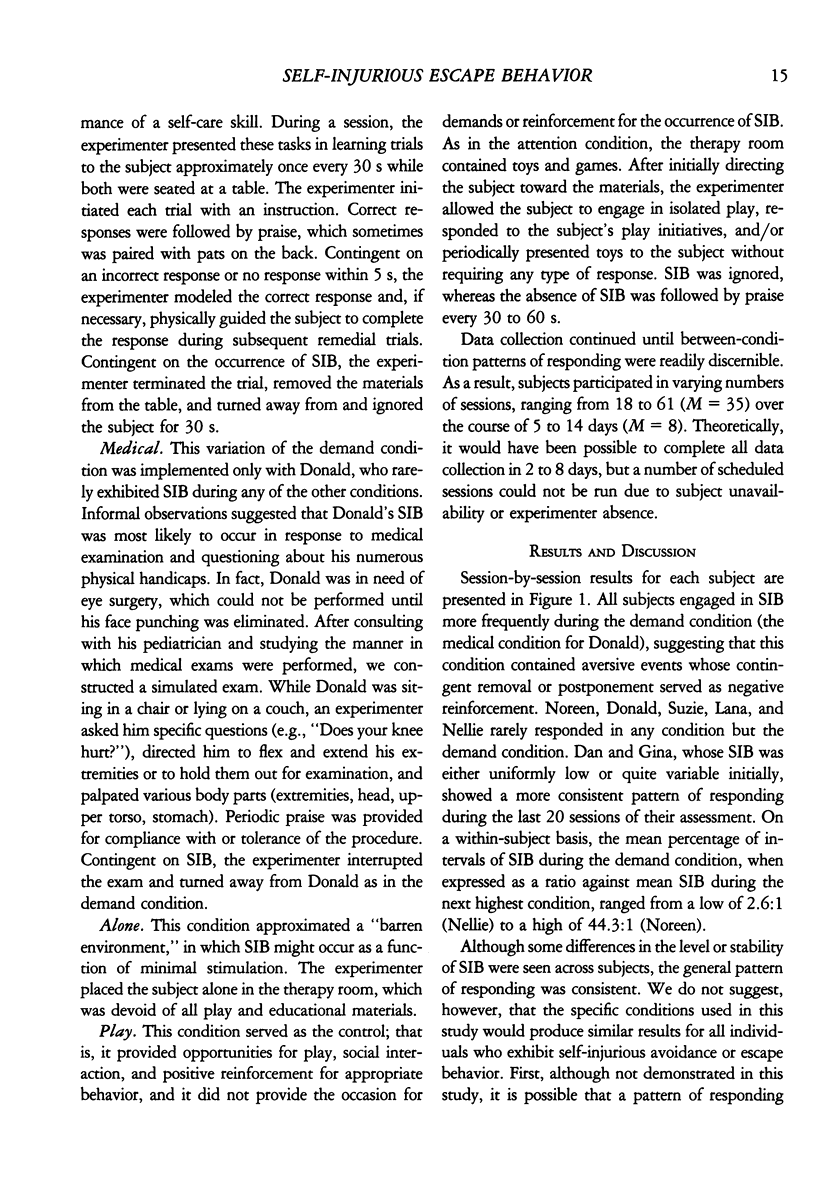
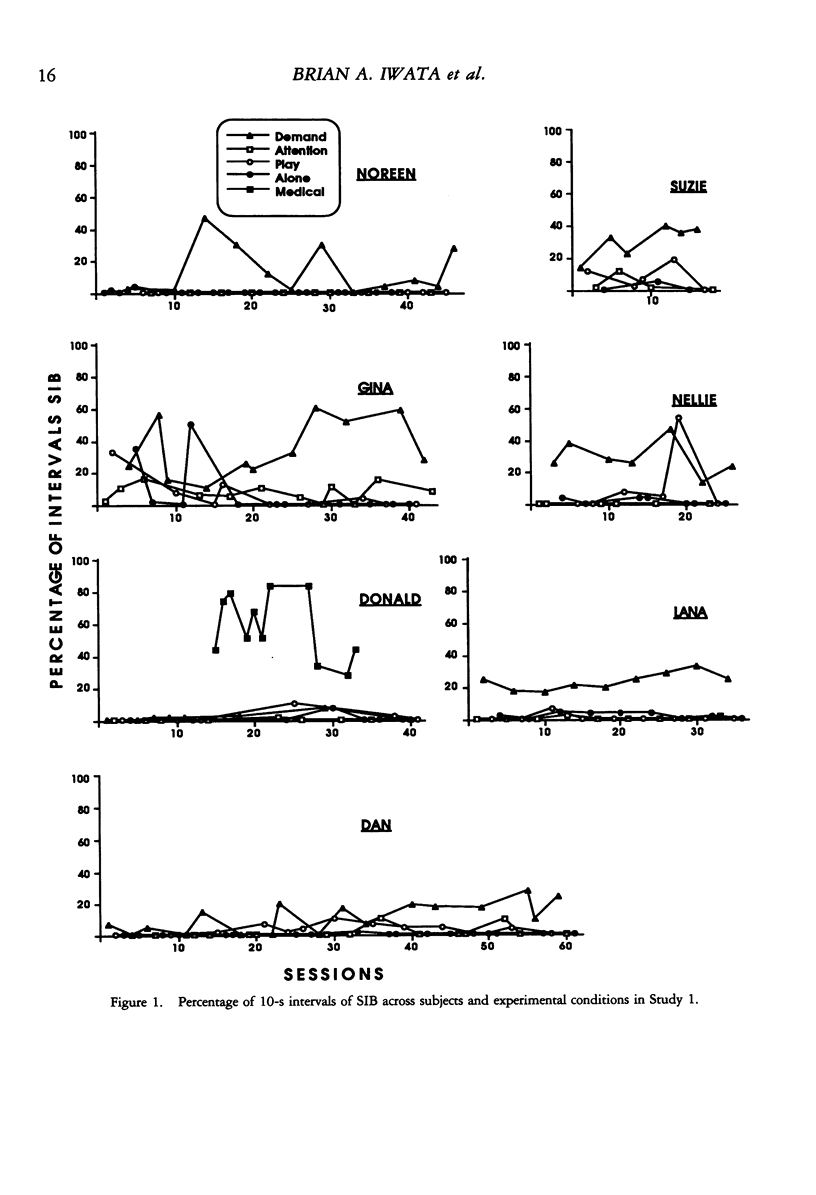


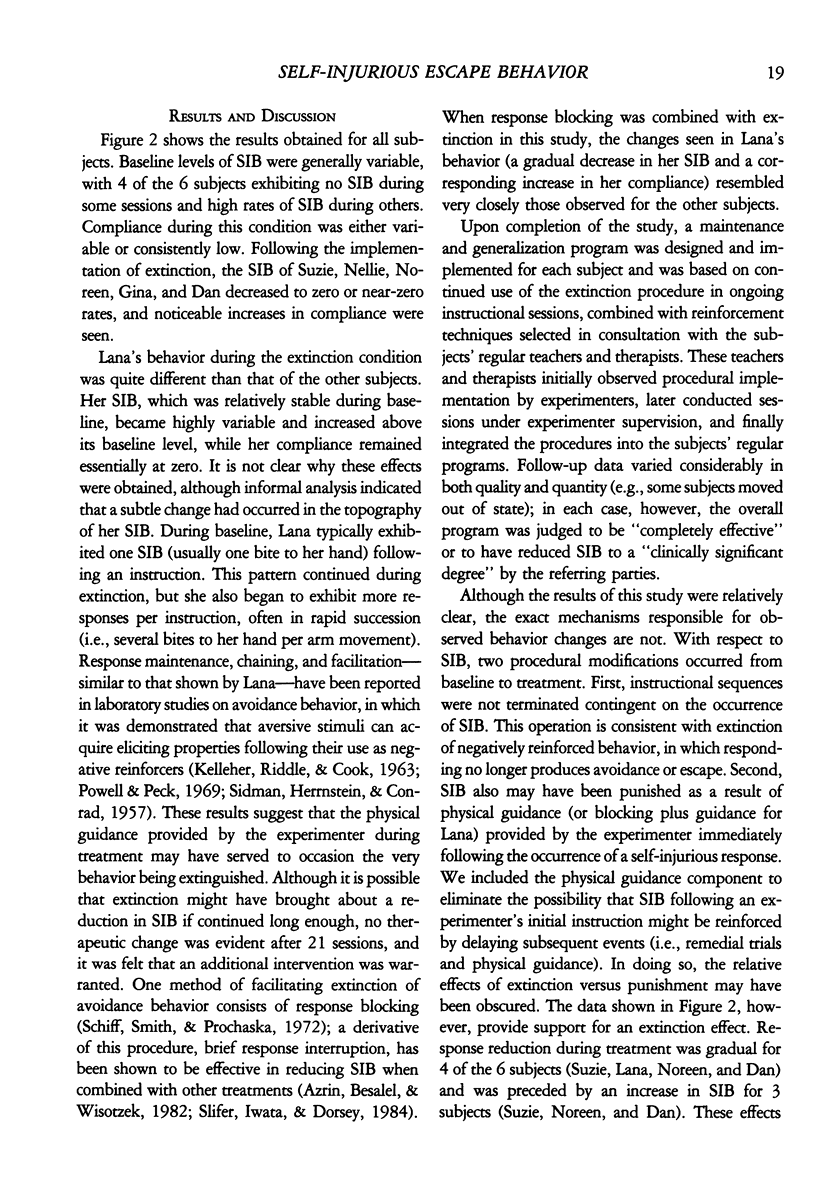
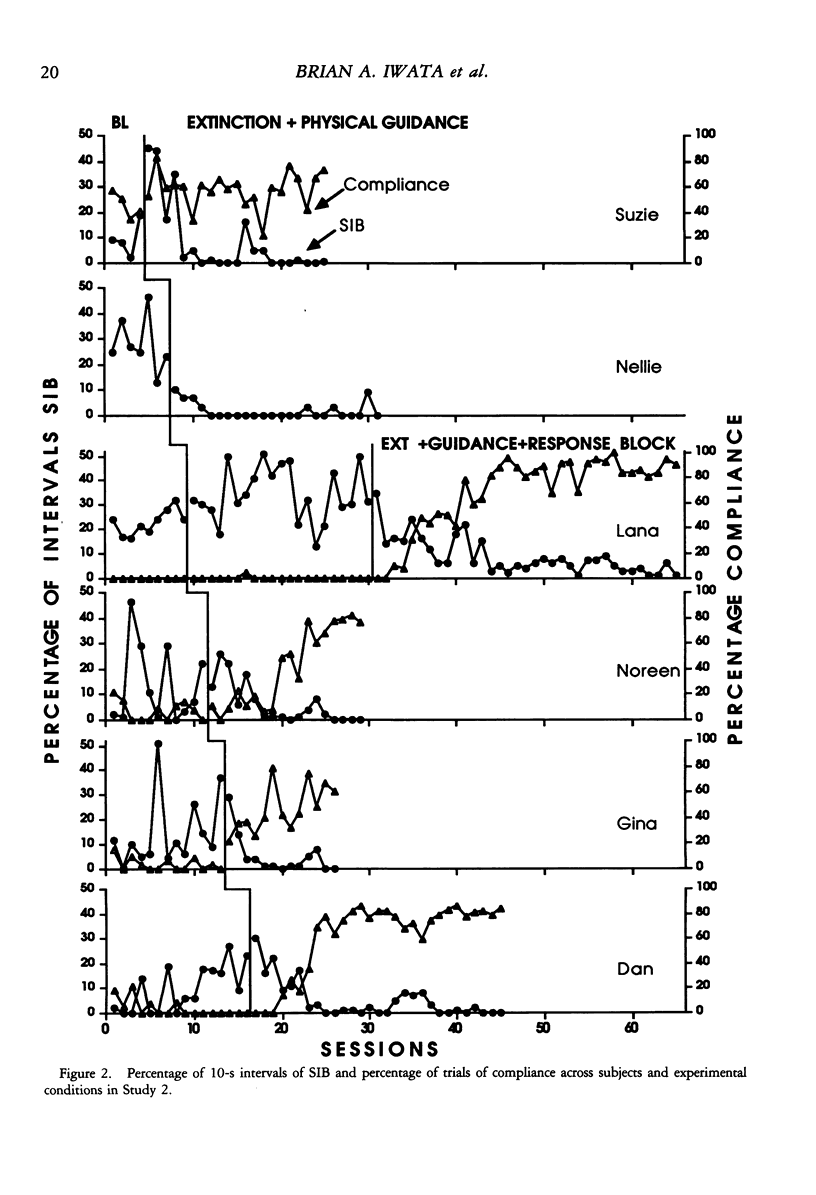

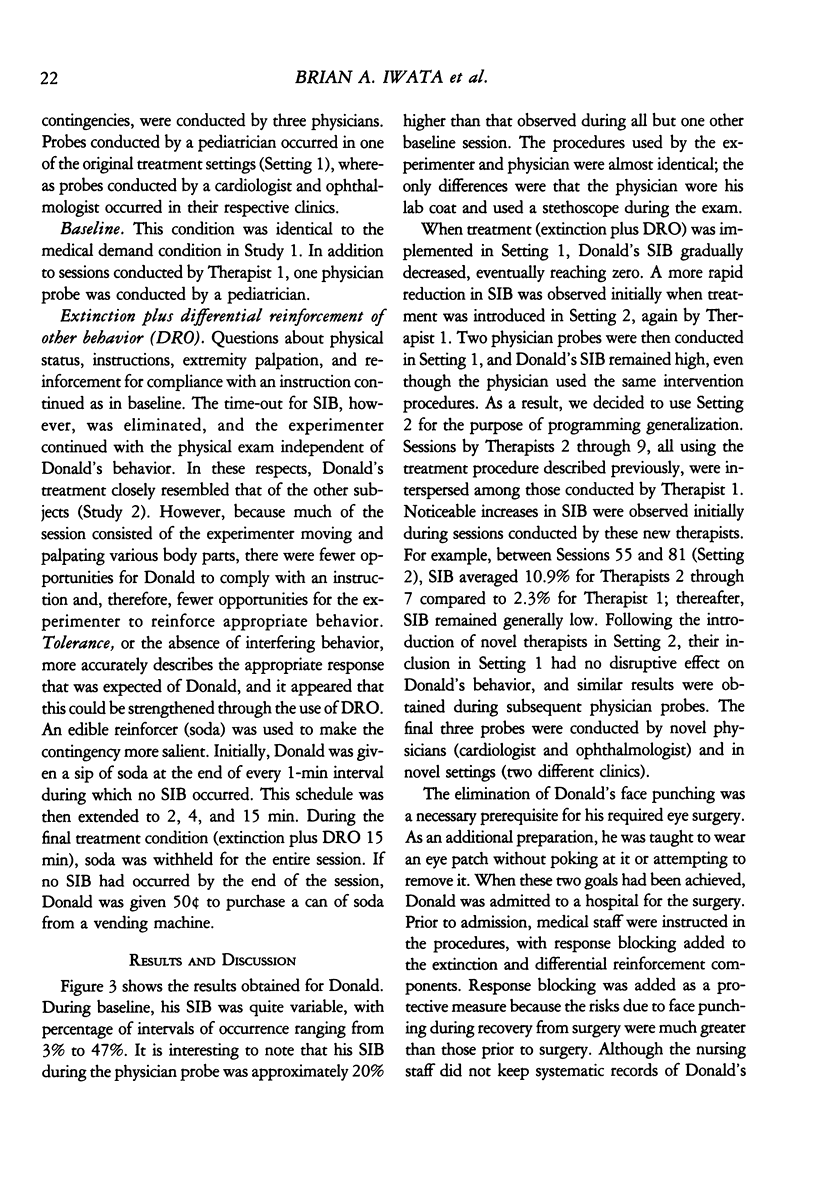
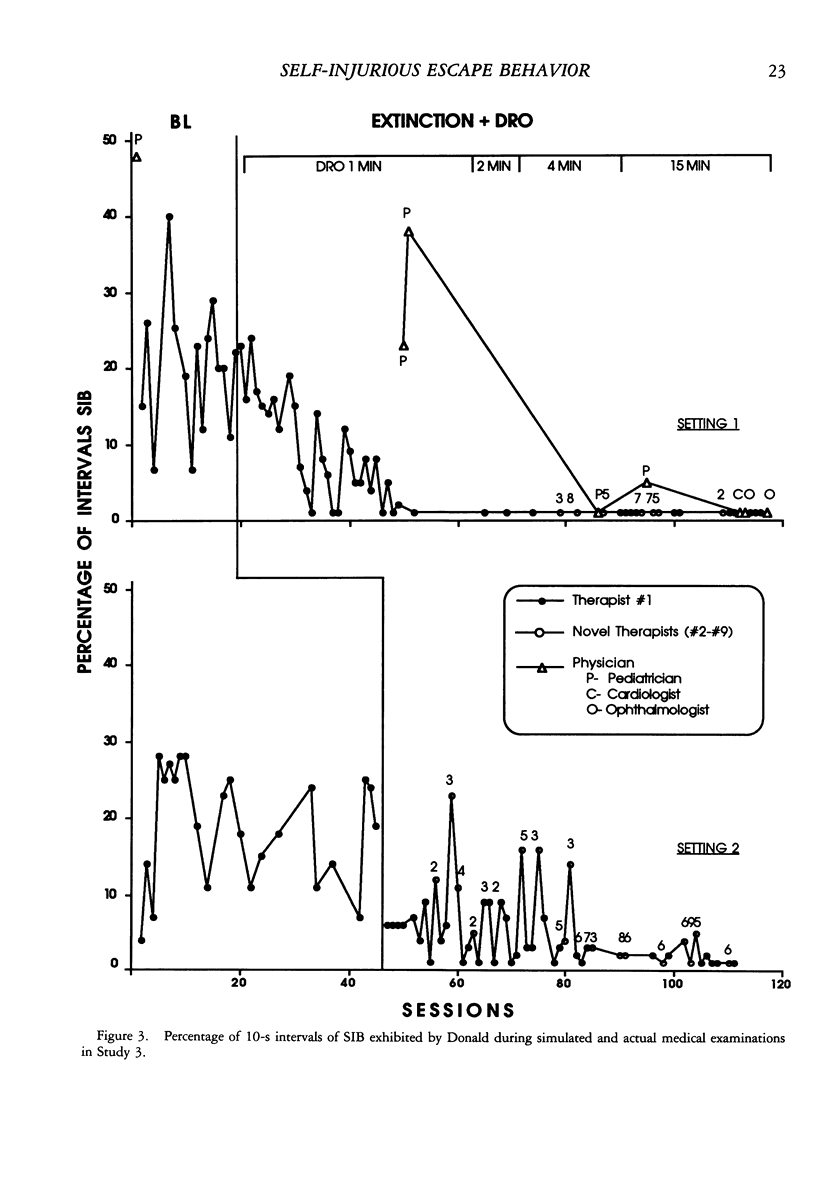
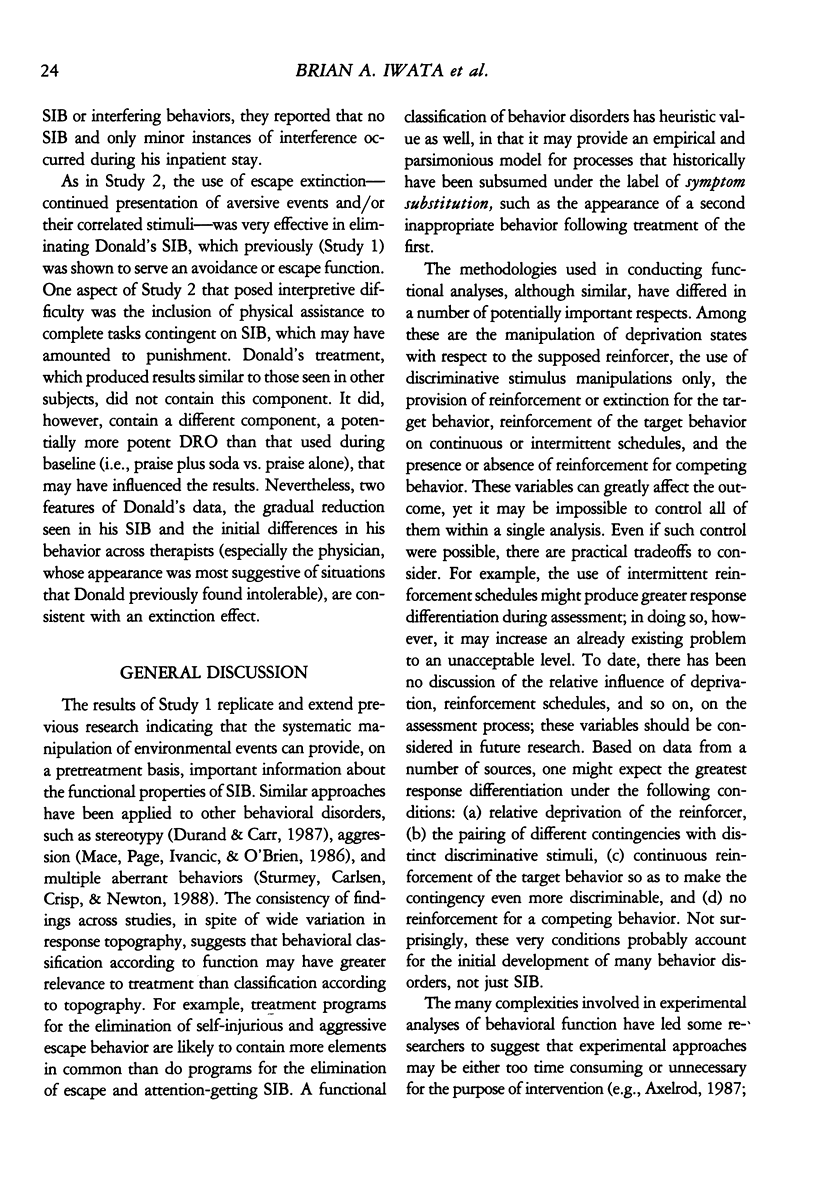


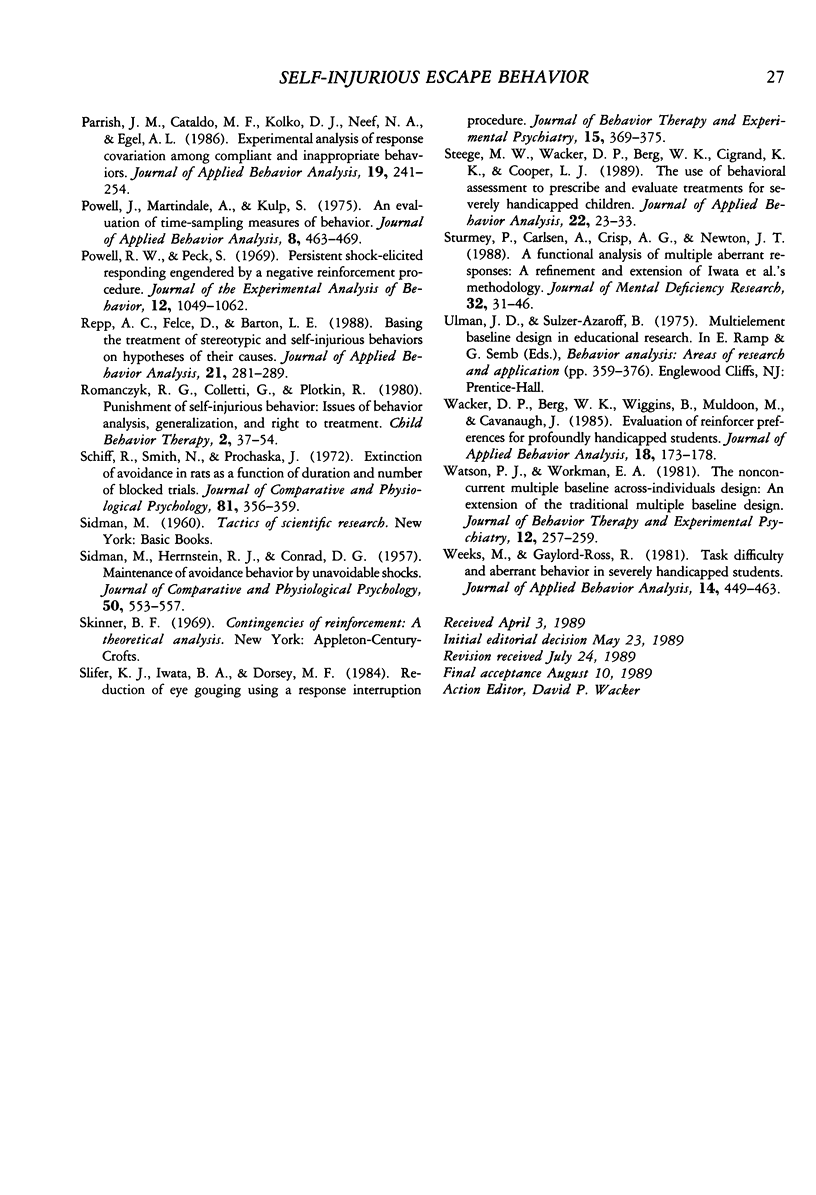
Selected References
These references are in PubMed. This may not be the complete list of references from this article.
- Axelrod S. Functional and structural analyses of behavior: approaches leading to reduced use of punishment procedures? Res Dev Disabil. 1987;8(2):165–178. doi: 10.1016/0891-4222(87)90001-1. [DOI] [PubMed] [Google Scholar]
- Baer D. M., Wolf M. M., Risley T. R. Some current dimensions of applied behavior analysis. J Appl Behav Anal. 1968 Spring;1(1):91–97. doi: 10.1901/jaba.1968.1-91. [DOI] [PMC free article] [PubMed] [Google Scholar]
- Borreson P. M. The elimination of a self-injurious avoidance response through a forced running consequence. Ment Retard. 1980 Apr;18(2):73–77. [PubMed] [Google Scholar]
- Carr E. G., Durand V. M. Reducing behavior problems through functional communication training. J Appl Behav Anal. 1985 Summer;18(2):111–126. doi: 10.1901/jaba.1985.18-111. [DOI] [PMC free article] [PubMed] [Google Scholar]
- Carr E. G., Newsom C. D., Binkoff J. A. Stimulus control of self-destructive behavior in a psychotic child. J Abnorm Child Psychol. 1976;4(2):139–153. doi: 10.1007/BF00916518. [DOI] [PubMed] [Google Scholar]
- Carr E. G. The motivation of self-injurious behavior: a review of some hypotheses. Psychol Bull. 1977 Jul;84(4):800–816. [PubMed] [Google Scholar]
- Corte H. E., Wolf M. M., Locke B. J. A comparison of procedures for eliminating self-injurious behavior of retarded adolescents. J Appl Behav Anal. 1971 Fall;4(3):201–213. doi: 10.1901/jaba.1971.4-201. [DOI] [PMC free article] [PubMed] [Google Scholar]
- Day R. M., Rea J. A., Schussler N. G., Larsen S. E., Johnson W. L. A functionally based approach to the treatment of self-injurious behavior. Behav Modif. 1988 Oct;12(4):565–589. doi: 10.1177/01454455880124005. [DOI] [PubMed] [Google Scholar]
- Durand V. M., Carr E. G. Social influences on "self-stimulatory" behavior: analysis and treatment application. J Appl Behav Anal. 1987 Summer;20(2):119–132. doi: 10.1901/jaba.1987.20-119. [DOI] [PMC free article] [PubMed] [Google Scholar]
- Durand V. M., Crimmins D. B. Identifying the variables maintaining self-injurious behavior. J Autism Dev Disord. 1988 Mar;18(1):99–117. doi: 10.1007/BF02211821. [DOI] [PubMed] [Google Scholar]
- Heidorn S. D., Jensen C. C. Generalization and maintenance of the reduction of self-injurious behavior maintained by two types of reinforcement. Behav Res Ther. 1984;22(5):581–586. doi: 10.1016/0005-7967(84)90062-7. [DOI] [PubMed] [Google Scholar]
- Iwata B. A. Negative reinforcement in applied behavior analysis: an emerging technology. J Appl Behav Anal. 1987 Winter;20(4):361–378. doi: 10.1901/jaba.1987.20-361. [DOI] [PMC free article] [PubMed] [Google Scholar]
- KELLEHER R. T., RIDDLE W. C., COOK L. PERSISTENT BEHAVIOR MAINTAINED BY UNAVOIDABLE SHOCKS. J Exp Anal Behav. 1963 Oct;6:507–517. doi: 10.1901/jeab.1963.6-507. [DOI] [PMC free article] [PubMed] [Google Scholar]
- Mace F. C., Page T. J., Ivancic M. T., O'Brien S. Analysis of environmental determinants of aggression and disruption in mentally retarded children. Appl Res Ment Retard. 1986;7(2):203–221. doi: 10.1016/0270-3092(86)90006-8. [DOI] [PubMed] [Google Scholar]
- Mellitz M., Hineline P. N., Whitehouse W. G., Laurence M. T. Duration-reduction of avoidance sessions as negative reinforcement. J Exp Anal Behav. 1983 Jul;40(1):57–67. doi: 10.1901/jeab.1983.40-57. [DOI] [PMC free article] [PubMed] [Google Scholar]
- Michael J. Distinguishing between discriminative and motivational functions of stimuli. J Exp Anal Behav. 1982 Jan;37(1):149–155. doi: 10.1901/jeab.1982.37-149. [DOI] [PMC free article] [PubMed] [Google Scholar]
- Pace G. M., Ivancic M. T., Edwards G. L., Iwata B. A., Page T. J. Assessment of stimulus preference and reinforcer value with profoundly retarded individuals. J Appl Behav Anal. 1985 Fall;18(3):249–255. doi: 10.1901/jaba.1985.18-249. [DOI] [PMC free article] [PubMed] [Google Scholar]
- Parrish J. M., Cataldo M. F., Kolko D. J., Neef N. A., Egel A. L. Experimental analysis of response covariation among compliant and inappropriate behaviors. J Appl Behav Anal. 1986 Fall;19(3):241–254. doi: 10.1901/jaba.1986.19-241. [DOI] [PMC free article] [PubMed] [Google Scholar]
- Powell J., Martindale A., Kulp S. An evaluation of time-sample measures of behavior. J Appl Behav Anal. 1975 Winter;8(4):463–469. doi: 10.1901/jaba.1975.8-463. [DOI] [PMC free article] [PubMed] [Google Scholar]
- Powell R. W., Peck S. Persistent shock-elicited responding engendered by a negative-reinforcement procedure. J Exp Anal Behav. 1969 Nov;12(6):1049–1062. doi: 10.1901/jeab.1969.12-1049. [DOI] [PMC free article] [PubMed] [Google Scholar]
- Repp A. C., Felce D., Barton L. E. Basing the treatment of stereotypic and self-injurious behaviors on hypotheses of their causes. J Appl Behav Anal. 1988 Fall;21(3):281–289. doi: 10.1901/jaba.1988.21-281. [DOI] [PMC free article] [PubMed] [Google Scholar]
- SIDMAN M., HERRNSTEIN R. J., CONRAD D. G. Maintenance of avoidance behavior by unavoidable shocks. J Comp Physiol Psychol. 1957 Dec;50(6):553–557. doi: 10.1037/h0043500. [DOI] [PubMed] [Google Scholar]
- Schiff R., Smith N., Prochaska J. Extinction of avoidance in rats as a function of duration and number of blocked trials. J Comp Physiol Psychol. 1972 Nov;81(2):356–359. doi: 10.1037/h0033540. [DOI] [PubMed] [Google Scholar]
- Slifer K. J., Iwata B. A., Dorsey M. F. Reduction of eye gouging using a response interruption procedure. J Behav Ther Exp Psychiatry. 1984 Dec;15(4):369–375. doi: 10.1016/0005-7916(84)90104-6. [DOI] [PubMed] [Google Scholar]
- Steege M. W., Wacker D. P., Berg W. K., Cigrand K. K., Cooper L. J. The use of behavioral assessment to prescribe and evaluate treatments for severely handicapped children. J Appl Behav Anal. 1989 Spring;22(1):23–33. doi: 10.1901/jaba.1989.22-23. [DOI] [PMC free article] [PubMed] [Google Scholar]
- Sturmey P., Carlsen A., Crisp A. G., Newton J. T. A functional analysis of multiple aberrant responses: a refinement and extension of Iwata et al.'s (1982) methodology. J Ment Defic Res. 1988 Feb;32(Pt 1):31–46. doi: 10.1111/j.1365-2788.1988.tb01386.x. [DOI] [PubMed] [Google Scholar]
- Wacker D. P., Berg W. K., Wiggins B., Muldoon M., Cavanaugh J. Evaluation of reinforcer preferences for profoundly handicapped students. J Appl Behav Anal. 1985 Summer;18(2):173–178. doi: 10.1901/jaba.1985.18-173. [DOI] [PMC free article] [PubMed] [Google Scholar]
- Watson P. J., Workman E. A. The non-concurrent multiple baseline across-individuals design: an extension of the traditional multiple baseline design. J Behav Ther Exp Psychiatry. 1981 Sep;12(3):257–259. doi: 10.1016/0005-7916(81)90055-0. [DOI] [PubMed] [Google Scholar]
- Weeks M., Gaylord-Ross R. Task difficulty and aberrant behavior in severely handicapped students. J Appl Behav Anal. 1981 Winter;14(4):449–463. doi: 10.1901/jaba.1981.14-449. [DOI] [PMC free article] [PubMed] [Google Scholar]


